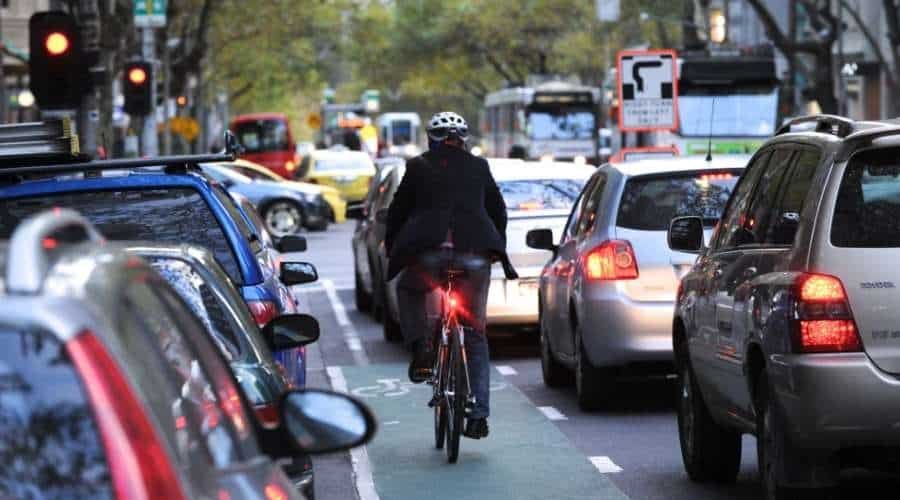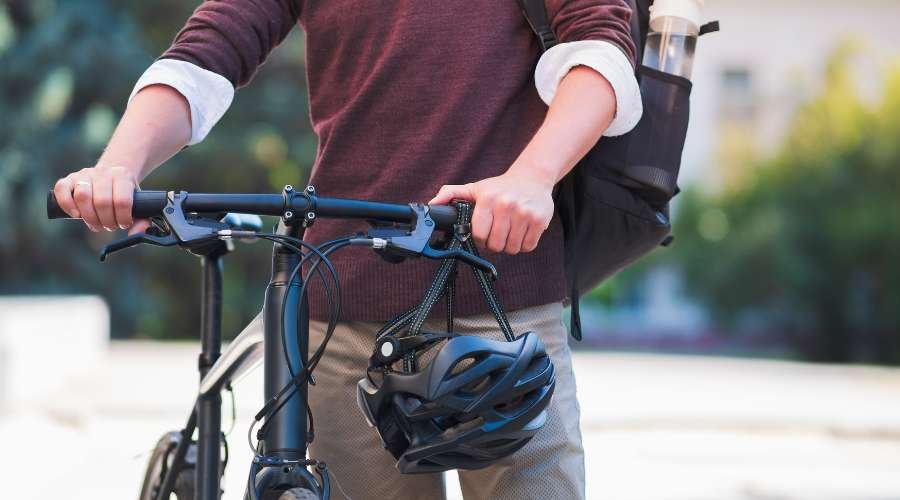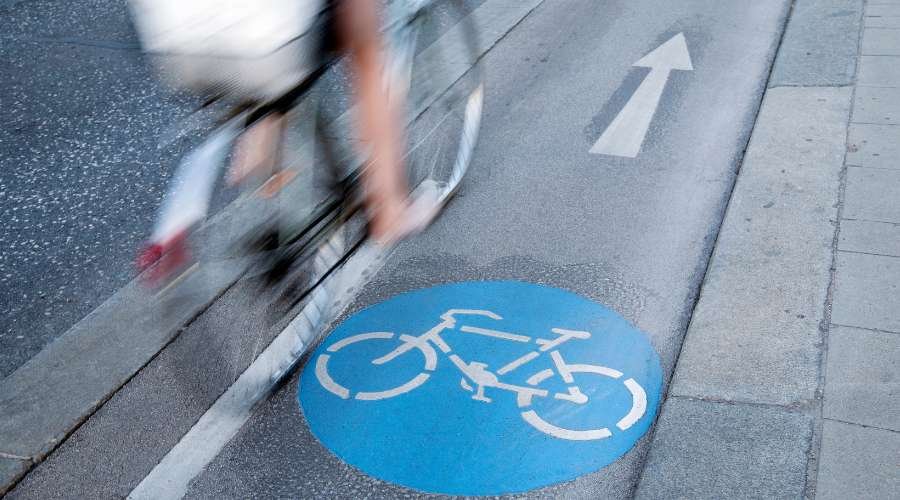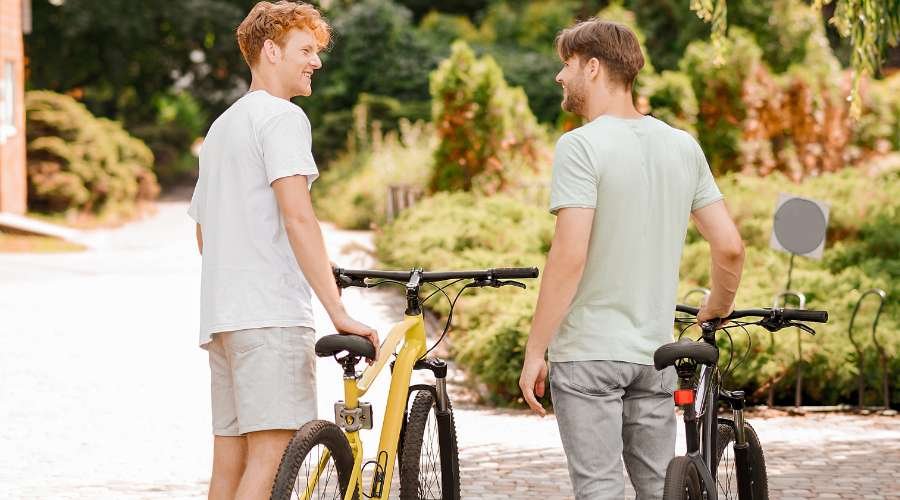Are you tired of spending precious hours stuck in traffic during your daily commute? Have you ever considered an alternative that not only gets you to your destination faster but also reduces your carbon footprint?
Every day, countless commuters grapple with the frustration of gridlock traffic. It’s a common woe that affects urban areas worldwide, exacerbated by population growth and an overreliance on cars. Evening rush hours often turn a 20-minute journey into an hour-long ordeal.
But what if there was a solution that could change the way we commute? E-bikes might just be the answer. They share the familiar frame of a bicycle but come equipped with an electric motor that provides an extra boost as you pedal. This means you can cover longer distances and reach speeds of up to 28 mph without breaking a sweat.
One of the biggest advantages of e-bikes is their ability to tackle those longer commutes with ease. Say goodbye to worrying about arriving at work or school tired and sweaty. E-bikes offer not only a practical solution but also an opportunity to incorporate physical activity into your daily routine.
In this article, we will explore the rise of e-bikes and their impact on traffic congestion, safety considerations, regulations, environmental implications, and more. Join us on this journey as we delve into the world of e-bikes and their potential to transform the way we commute.
E-Bikes: The New Commuting Trend

According to a New York Times article, e-bike sales grew by 145% from 2019 to 2020, outpacing sales of traditional bikes.
If you’re tired of sitting in traffic every morning on your way to work, it might be time to consider an e-bike. E-bikes, or electric bicycles, are quickly becoming the new commuting trend, offering a faster, more convenient, and eco-friendly way to get around.
E-bikes are similar to regular bikes, but they have an electric motor that assists with pedaling. This means you can travel longer distances and reach higher speeds without breaking a sweat. In fact, many e-bikes can reach top speeds of up to 28 mph, making them a great alternative to traditional transportation methods such as cars, buses, and trains.
One of the biggest advantages of e-bikes is their ability to cover longer distances than traditional bikes. This means you can travel further to work or school without worrying about getting tired or sweaty. E-bikes also offer a great way to get some exercise and physical activity while commuting, as you can choose to pedal or let the electric motor do the work for you.
Not only are e-bikes a great way to stay active and reduce traffic congestion, but they are also becoming more affordable and widely available. According to a New York Times article, e-bike sales grew by 145% from 2019 to 2020, outpacing sales of traditional bikes. This trend is expected to continue as more people look for eco-friendly and efficient ways to commute.
In conclusion, e-bikes are quickly becoming the new commuting trend, offering a faster, more convenient, and eco-friendly way to get around. With their ability to cover longer distances, get some exercise, and reduce traffic congestion, it’s no wonder why more people are turning to e-bikes as their primary mode of transportation.
Traffic Congestion: The Urban Nightmare

You know the feeling. You’re stuck in traffic, inching forward at a snail’s pace, watching the minutes tick by on your dashboard clock. You’re late for work, for an appointment, for a date. You’re frustrated, stressed, and angry. You’re not alone.
Traffic congestion is a major problem in urban areas around the world. It’s caused by a variety of factors, including population growth, urbanization, inadequate infrastructure, and a reliance on cars. The result is gridlock, delays, and wasted time.
The congestion effect is particularly noticeable during evening commutes. As more people leave work and hit the roads, traffic volume increases, and travel times skyrocket. It’s not uncommon for a trip that would take 20 minutes in light traffic to take an hour or more during rush hour.
Car trips are the primary contributor to traffic congestion. In many urban areas, cars account for more than 90% of all trips. This reliance on cars has a number of negative consequences, including increased air pollution, higher carbon emissions, and reduced physical activity.
So, what can be done to address traffic congestion in urban areas? One solution is to promote alternative modes of transportation, such as public transit, walking, and cycling. E-bikes, in particular, have been shown to reduce traffic congestion and travel times in some cities.
But reducing traffic congestion isn’t just about promoting alternative modes of transportation. It’s also about improving infrastructure, managing demand, and changing behavior. By investing in public transit, building bike lanes, and implementing congestion pricing, cities can reduce the number of cars on the road and make travel more efficient for everyone.
Micromobility Solutions to Traffic Woes

If you’re tired of being stuck in traffic or waiting for public transportation, micromobility solutions might be just what you need. Micromobility refers to small, lightweight modes of transportation that are typically powered by electricity or human power. Shared micromobility devices, such as e-bikes and e-scooters, are becoming increasingly popular in cities around the world as more people look for sustainable and convenient ways to get around.
One of the main benefits of micromobility solutions is that they can help reduce vehicle miles traveled, which is a key contributor to traffic congestion and air pollution. By replacing car trips with e-bike or e-scooter trips, you can help reduce the number of cars on the road and make your city a more livable place.
E-bikes reduce traffic congestion and travel time.
Another advantage of micromobility solutions is that they can help promote sustainable transportation infrastructure. When more people use e-bikes and e-scooters, cities may be more likely to invest in bike lanes, bike parking, and other amenities that make it easier and safer to use these modes of transportation. This can help create a virtuous cycle where more people feel comfortable using micromobility solutions, which in turn leads to more investment in sustainable transportation infrastructure.
Of course, micromobility solutions aren’t a silver bullet for all traffic woes. They may not be suitable for everyone’s travel behaviour, and there are still some challenges that need to be addressed, such as safety concerns and the need for more equitable access to these devices. However, as more people discover the benefits of micromobility solutions, it’s likely that we’ll see continued growth in this area and more innovations that make it easier and more convenient to get around in our cities.
E-Bikes and Public Safety

When it comes to public safety, e-bikes have been a topic of debate in recent years. While they offer a convenient and eco-friendly mode of transportation, there are concerns about their potential impact on safety, particularly when it comes to accidents and injuries.
According to a study, e-bikes and electric scooters carry a higher risk of severe injuries than traditional bicycles and scooters. This is partly due to their higher speeds and the fact that riders may not be as experienced or skilled as traditional cyclists.
To reduce the risk of accidents and injuries, it’s important to take appropriate safety measures when riding an e-bike. This includes wearing a helmet, obeying traffic laws, using designated bike lanes or paths, and avoiding riding in inclement weather or at night.
In addition to individual safety measures, there are also regulations and policies in place to promote public safety. For example, some cities have implemented rules around where e-bikes can be ridden, such as banning them from dirt trails or requiring riders to have a valid driver’s license.
Overall, while e-bikes offer many benefits, it’s important to prioritize public safety and take appropriate measures to reduce the risk of accidents and injuries. By following safety guidelines and regulations, you can enjoy the convenience and freedom of e-bike transportation while also keeping yourself and others safe.
Regulation and Compliance of E-Bikes

When it comes to e-bikes, regulations and compliance are important factors to consider. Different states and countries have varying laws and regulations regarding e-bikes. Some may ban e-bikes altogether, while others may have geofencing policies or no-ride zones in place.
To ensure compliance, manufacturers and importers must ensure that their e-bikes meet safety requirements outlined in 16 CFR Part 1512. These requirements include mechanical specifications, such as those for pedals, tires, and front forks, as well as labeling and reflector requirements.
State legislatures have also begun to grapple with how to differentiate and define e-bikes and regulate their operation and equipment standards on roadways and trails in their respective states. This has led to a patchwork of regulations across the country, with some states allowing e-bikes on bike paths and trails, while others do not.
It is important for e-bike riders to be aware of the regulations in their area and comply with them. Failure to do so may result in fines or even the impounding of the e-bike.
Overall, while regulations and compliance may seem like a burden, they are necessary to ensure the safety of e-bike riders and those around them. By following the rules and regulations in your area, you can enjoy the benefits of e-bikes without putting yourself or others in danger.
Environmental Impact of E-Bikes

When it comes to the environmental impact of e-bikes, there is a lot of debate. Some argue that e-bikes are a more environmentally friendly mode of transportation than cars, while others argue that they still contribute to pollution and greenhouse gas emissions.
E-bikes produce an average of 22 grams of CO2 per kilometer traveled, compared to 271 grams for cars – a significant reduction in carbon emissions.
One thing is clear: e-bikes produce far fewer emissions than cars. According to a study published in the journal Transportation Research and Education Center, e-bikes produce an average of 22 grams of CO2 per kilometer traveled, compared to 271 grams for cars. This means that e-bikes could play a significant role in reducing carbon emissions and combating climate change.
However, there are still some environmental concerns associated with e-bikes. For example, the batteries used in e-bikes contain chemicals that can be harmful to the environment if not disposed of properly. Additionally, the production of e-bikes and their components can also contribute to pollution and emissions.
Despite these concerns, e-bikes are still a relatively eco-friendly mode of transportation. In fact, a study published by The Guardian reveals that manufacturing the average commuter ebike could emit about 165kg of CO2e. This is much lower than the manufacturing footprint of cars and other motorized vehicles.
Overall, while e-bikes may not be a perfect solution to environmental concerns, they are certainly a step in the right direction. By choosing to ride an e-bike instead of driving a car, you can significantly reduce your carbon footprint and contribute to a more sustainable future.
Case Studies: E-Bikes in Different Cities

E-bikes have been implemented in various cities around the world, with mixed results. Here are a few case studies to consider:
Atlanta
In Atlanta, a natural experiment was conducted to study the impact of e-bikes on traffic congestion. The city introduced a “No Ride Zone” policy, which banned shared micromobility devices (including e-bikes and electric scooters) in the city’s most congested areas. The study found that this policy actually increased traffic congestion in the city center, as people who would have used e-bikes or electric scooters instead opted for cars. This highlights the importance of providing alternative transportation options to reduce traffic congestion.
Paris
Paris has been a leader in promoting e-bikes as a sustainable transportation option. The city has implemented an extensive network of bike lanes and bike-sharing programs, including the popular Vélib’ system. During the COVID-19 pandemic, the city saw a surge in e-bike usage as people sought to avoid public transportation. This trend has continued even as restrictions have lifted, with e-bikes becoming a more common sight on the city’s streets.
San Francisco
San Francisco has also embraced e-bikes as a way to reduce traffic congestion and promote sustainability. The city has implemented a number of bike lanes and bike-sharing programs, including the Ford GoBike system. However, the city has also faced challenges in managing the influx of e-bikes and electric scooters, particularly during stadium events. The city has implemented regulations to address these issues, including requiring companies to obtain permits and limiting the number of devices allowed on the streets.
Mercedes-Benz Stadium
In Atlanta, the Mercedes-Benz Stadium has implemented a unique approach to promoting sustainable transportation. The stadium offers free bike valet services and has partnered with the city’s bike-sharing program to provide discounted rides to and from the stadium. This has helped to reduce traffic congestion and promote sustainable transportation options for stadium events.
Overall, these case studies demonstrate the potential of e-bikes to reduce traffic congestion and promote sustainability. However, they also highlight the importance of implementing infrastructure and policies to support e-bike usage and manage potential challenges.
Economic and Social Implications

E-bikes have the potential to significantly impact the economy, both positively and negatively. On one hand, the rise of e-bikes can lead to a decrease in car usage, which can reduce traffic congestion and lower the demand for fuel. This can also lead to a reduction in greenhouse gas emissions, which can have a positive impact on the environment.
On the other hand, the increased use of e-bikes can also lead to a reduction in revenue for public transportation systems and car manufacturers. Additionally, there may be a need for new infrastructure to accommodate the rise of e-bikes, which can be costly.
In terms of social implications, the rise of e-bikes can lead to increased accessibility and mobility for individuals who may not have access to a car or public transportation. This can lead to increased economic opportunities and social inclusion.
However, there are also concerns about the safety of e-bikes and their impact on pedestrian and cyclist safety. This has led to debates about regulations and best practices for e-bike usage in American cities.
The School of Public Policy has conducted research on the impact of e-bikes on traffic congestion and found that “the use of e-bikes can lead to a reduction in traffic congestion and travel time“. However, there is still a need for further research on the long-term impact of e-bikes on traffic patterns and urban planning.
Overall, the rise of e-bikes presents both opportunities and challenges for the economy and society. It is important for policymakers and stakeholders to consider the potential economic and social implications of e-bikes and work towards implementing best practices for their usage.
Conclusion
In conclusion, the debate surrounding e-bikes and traffic congestion is complex and multifaceted. While some studies suggest that e-bikes can reduce traffic congestion, others argue that they may actually increase it.
One of the main factors that contribute to this debate is the lack of standardized regulations and infrastructure for e-bikes. As e-bikes become more popular, it is important for cities and governments to develop policies and infrastructure that support safe and efficient e-bike use. This includes designated bike lanes, parking areas, and regulations around speed limits and helmet use.
Another factor to consider is the potential impact of e-bikes on public transportation. While e-bikes may be seen as a more convenient and affordable alternative to public transportation, they may also lead to decreased ridership and revenue for public transit systems.
Ultimately, the impact of e-bikes on traffic congestion will depend on a variety of factors, including local regulations, infrastructure, and public perception. As e-bikes continue to grow in popularity, it will be important for policymakers and city planners to carefully consider these factors and develop strategies that promote safe and sustainable transportation options for all.

